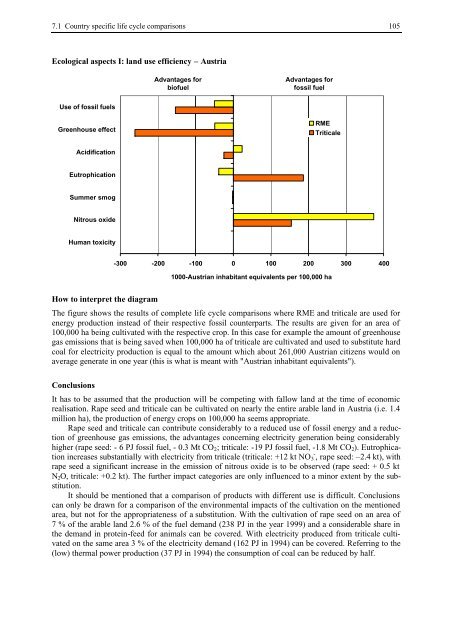BIOENERGY FOR EUROPE: WHICH ONES FIT BEST?
BIOENERGY FOR EUROPE: WHICH ONES FIT BEST?
BIOENERGY FOR EUROPE: WHICH ONES FIT BEST?
You also want an ePaper? Increase the reach of your titles
YUMPU automatically turns print PDFs into web optimized ePapers that Google loves.
7.1 Country specific life cycle comparisons 105<br />
Ecological aspects I: land use efficiency – Austria<br />
Use of fossil fuels<br />
Greenhouse effect<br />
Acidification<br />
Eutrophication<br />
Summer smog<br />
Nitrous oxide<br />
Human toxicity<br />
How to interpret the diagram<br />
Advantages for<br />
biofuel<br />
Advantages for<br />
fossil fuel<br />
RME<br />
Triticale<br />
-300 -200 -100 0 100 200 300 400<br />
1000-Austrian inhabitant equivalents per 100,000 ha<br />
The figure shows the results of complete life cycle comparisons where RME and triticale are used for<br />
energy production instead of their respective fossil counterparts. The results are given for an area of<br />
100,000 ha being cultivated with the respective crop. In this case for example the amount of greenhouse<br />
gas emissions that is being saved when 100,000 ha of triticale are cultivated and used to substitute hard<br />
coal for electricity production is equal to the amount which about 261,000 Austrian citizens would on<br />
average generate in one year (this is what is meant with "Austrian inhabitant equivalents").<br />
Conclusions<br />
It has to be assumed that the production will be competing with fallow land at the time of economic<br />
realisation. Rape seed and triticale can be cultivated on nearly the entire arable land in Austria (i.e. 1.4<br />
million ha), the production of energy crops on 100,000 ha seems appropriate.<br />
Rape seed and triticale can contribute considerably to a reduced use of fossil energy and a reduction<br />
of greenhouse gas emissions, the advantages concerning electricity generation being considerably<br />
higher (rape seed: - 6 PJ fossil fuel, - 0.3 Mt CO2; triticale: -19 PJ fossil fuel, -1.8 Mt CO2). Eutrophication<br />
increases substantially with electricity from triticale (triticale: +12 kt NO3 - , rape seed: –2.4 kt), with<br />
rape seed a significant increase in the emission of nitrous oxide is to be observed (rape seed: + 0.5 kt<br />
N2O, triticale: +0.2 kt). The further impact categories are only influenced to a minor extent by the substitution.<br />
It should be mentioned that a comparison of products with different use is difficult. Conclusions<br />
can only be drawn for a comparison of the environmental impacts of the cultivation on the mentioned<br />
area, but not for the appropriateness of a substitution. With the cultivation of rape seed on an area of<br />
7 % of the arable land 2.6 % of the fuel demand (238 PJ in the year 1999) and a considerable share in<br />
the demand in protein-feed for animals can be covered. With electricity produced from triticale cultivated<br />
on the same area 3 % of the electricity demand (162 PJ in 1994) can be covered. Referring to the<br />
(low) thermal power production (37 PJ in 1994) the consumption of coal can be reduced by half.

















